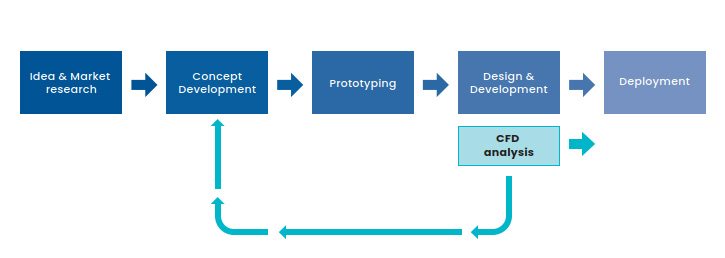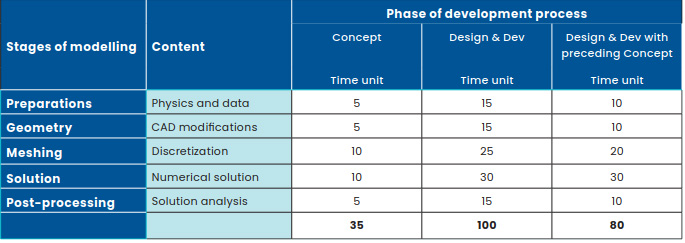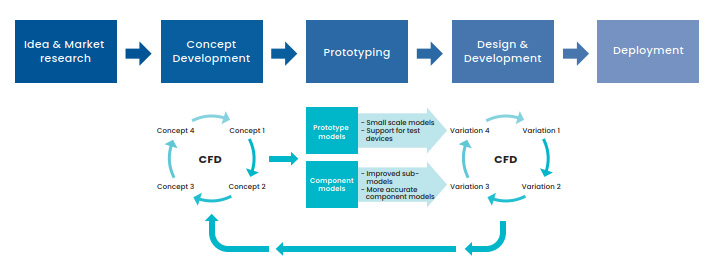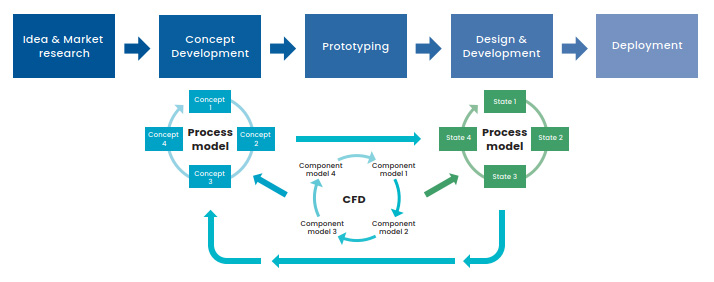01/12/2022
Finding the full potential of CFD
CFD, or Computational Fluid Dynamics, is a method that is often utilized only for the post-design phase, although it is very well suited for wider and efficient use throughout the design process. Optimal use of CFD analysis generally shortens projects’ lead times and improves product assessment. It also provides an excellent basis for preparing digital twins. In process modeling tasks, CFD is an excellent tool for studying the components, for example.
CFD is a branch of fluid mechanics that uses numerical analysis and data structures to analyze and solve problems that involve fluid flows. It uses computers to perform the calculations required to simulate the free-stream flow of liquids and gases, and their interaction with surfaces defined by boundary conditions.
The method is applied to a wide range of research and engineering problems in natural science and industry. The traditional, well-known fields are aerodynamics, aerospace analysis, marine engineering, weather simulation, environmental engineering, and industrial system and equipment design. However, CFD is not only a method of fluid flow, but all processes and equipment linked to flows through heat transfer, chemical and biological reactions or transport of particulate matter.
Therefore, CFD is suitable for many different types of design processes. In the following, I have tried to elucidate the optimal role and the most productive ways to utilize CFD as a part of the design process.
Benefits of CFD are lost if it is applied only in the post-design phase
Some 20–30 years ago, when CFD made its strong entry, it suffered from somewhat too long analysis times for efficient development work and, especially, for desired design process lead times. This major shortcoming appeared through several sources, like 2D design systems, forcing the creation of separate 3D models for analysis, the need to create structured element meshes for solutions, and insufficient solution power.
These shortages led to the application of CFD analysis mostly to check accepted designs. In this way, most of the benefits of CFD are lost since weaknesses or even inoperability of the design are found out far too late and lead to a repeated design process. Typically, related to the post-design analysis, the number of different analyzed model variations is also very low, leaving space for incorrect conclusions.
This approach, called the traditional process, has clear drawbacks. When modeling only serves to check design, knowledge is not created through modeling, and the information produced in the modeling phase is only partially utilized. Also, the accepted design can no longer be modified much. Changes and development ideas mean a return to the concept phase, resulting in slow and expensive changes. In addition, the modeling approach and sub-models do not improve in the process, but the same type of methods will be applied in later design.
As a result, investment in modeling may fail due to an unsuitable approach. However, CFD is a tool that can be utilized at different levels of complexity and details, positioning it also in the concept phase. In addition, CFD has new roles as part of the design process.

Concept phase modeling takes product assessment to a new level
In the early adaptors process, the drawbacks of the traditional process are avoided by associating modeling with design already in the concept phase. The concept design models are much faster to create with CFD, which is applied with more approximate models and with lower local resolution (element mesh). Better screening in the concept phase also leads to better design and reduced risks. CFD can also provide improved information and indicate critical parts or components in design.
In the design and development phase, the base model can be utilized for parametric studies and small changes in design, providing wider gain of the base model. It also provides information on the sensitivity and features of design.

Accomplished studies confirm that there are clear advantages to this type of design process. Concept phase modeling improves most product assessments and leads to even more than collaboration between CFD experts and design, since concept-stage modeling focuses participants on key design areas. Already approximate modeling of concepts and ideas early in the process are very important for success. In addition, more expensive models in the design and development phase can be varied (parametric geometry, coverage of operational range) to improve utilization of later phase investment.
To further motivate the early adaption in the concept phase, estimates on the stages of a typical CFD modeling task are shown in table below. It can be stated that concept stage models are faster to perform. Time is estimated to be only one third of the duration of design and development phase. The models have impact over the whole process and even reduce time spent in later phases.

However, it is still obvious that there is a notable difference between the concept phase and the design and development phase, as the target and methods are different. Concept phase models do not directly support those later phases in the design process.
The development cycle can be considerably reduced
The basic idea behind the parallel modeling approach is quite straightforward. To enable design support at all stages, also modeling needs to develop along the process. In the regular design process, there is a notable time interval between the concept phase and the design and development phase. Often a prototype precedes the final design. This time slot is available for multiple supporting tasks like building prototype models for the planning of reliable and correct tests, a more profound interpretation of test results, developing concept phase models to cover challenges of the design and development phase, as well as conducting improved studies of critical components.

It is easy to see the benefits of this process. The development cycle is most reduced if concept phase modeling is supplemented by component models. This way, improved understanding of the selected concept can be achieved. The method also allows more profound analysis of selected components. In addition, verification and tests of critical components of the concept can be carried out before the final design.
In the typical process design, the notable difference is that CFD is not the natural tool of choice for full scope. This role is then addressed to the process modeling tool, which provides the framework for design. However, CFD is an excellent tool to support components of process modeling.
Also, the parallel modeling process produces a digital representation of the functionality of design as a natural outcome. This is as an additional deliverable of notable value since the applicability extends to later studies on process parameters and easy access to further development.

The parallel modeling process can also be applied to designs that are tailored with each delivery. The concept phase can be thought of as serving the offer stage, for example the modifications and context for which the design is intended. This can be handled with quick and more approximate models.
CFD even supports the creation of digital twins
A digital twin is a digital representation of an active unique product or unique product-service system that comprises its selected characteristics, properties, conditions, and behaviors by means of models, information, and data within a single or even across multiple life cycle phases.
Covering the full essence of a digital twin is highly demanding and takes a long development time. Therefore, only a few real digital twins exist. Most of them are targeted to improve design based on the collected sensor data. Accordingly, digital twins are regularly built for existing designs but seldom during a design process.
Of the covered design process types, the parallel modeling process provides the best way to underlay digital twins. Improved component models are built during the process, which leads to better description in the design and development phase and serves as an excellent model base for the post-inclusion of the control system. Also, it provides additional confidence for the design process if sensor data from earlier designs can be utilized.
Companies may worry that a parallel modeling process will lead to a complicated design process and organizational changes. It is also often heard that designers are not capable of handling such specialized modeling tasks as CFD. However, questionnaires addressed to successful industry in the field reveal that the best outcome is achieved when modeling tasks are kept separate from design.
Most of the benefits related to a parallel modeling process can be achieved by organizing tasks in the design process differently: although a separate group of specialists is needed, they should not be a separate group in the process.
Want to know more? Check out these related articles:
Fluid Dynamics
With our Computational Fluid Dynamics (CFD) services, you can analyze the fluid dynamics and heat or mass transfer of fluids and thereby develop your products. You also save time and money.
Not only colorful pictures – CFD saves time and money
Did you know that by using computational fluid dynamics (CFD) you can save as much as 80 % in design time and 60 % in design costs? During the past 20 years, I’ve been lucky enough to participate in many interesting simulation projects both in Finland and abroad and have seen how clients have received instant help. But what is CFD really? Where can it be applied and why should it be utilized?
